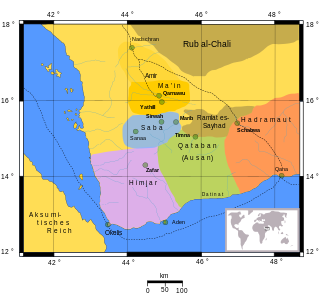Related Research Articles

Allah is the Arabic word for God, particularly the God of Abraham. Outside of the Middle East, it is principally associated with Islam, although the term was used in pre-Islamic Arabia and continues to be used today by Arabic-speaking adherents of any of the Abrahamic religions, including Judaism and Christianity. It is thought to be derived by contraction from al-ilāh and is linguistically related to God's names in other Semitic languages, such as Aramaic and Hebrew.

Indigenous Arabian polytheism, ancient Semitic religions, Christianity, Judaism, Mandaeism, and Zoroastrianism were among the religions in pre-Islamic Arabia.

Sheba, or Saba, was an ancient South Arabian kingdom in modern-day Yemen whose inhabitants were known as the Sabaeans or the tribe of Sabaʾ which, for much of the 1st millennium BCE, were indissociable from the kingdom itself. Modern historians agree that the heartland of the Sabaean civilization was located in the region around Marib and Sirwah. In some periods, they expanded to much of what is now modern-day Yemen and even parts of the Horn of Africa, in modern-day Ethiopia.

Himyar was a polity in the southern highlands of Yemen, as well as the name of the region which it claimed. Until 110 BCE, it was integrated into the Qatabanian kingdom, afterwards being recognized as an independent kingdom. According to classical sources, their capital was the ancient city of Zafar, relatively near the modern-day city of Sana'a. Himyarite power eventually shifted to Sana'a as the population increased in the fifth century. After the establishment of their kingdom, it was ruled by kings from dhū-Raydān tribe. The kingdom was named Raydān.

Sabaic, sometimes referred to as Sabaean, was an Sayhadic language that was spoken between c. 1000 BC and the 6th century AD by the Sabaeans. It was used as a written language by some other peoples of the ancient civilization of South Arabia, including the Ḥimyarites, Ḥashidites, Ṣirwāḥites, Humlanites, Ghaymānites, and Radmānites. Sabaic belongs to the South Arabian Semitic branch of the Afroasiatic language family. Sabaic is distinguished from the other members of the Sayhadic group by its use of h to mark the third person and as a causative prefix; all of the other languages use s1 in those cases. Therefore, Sabaic is called an h-language and the others s-languages. Numerous other Sabaic inscriptions have also been found dating back to the Sabean colonization of Africa.

Almaqah or Almuqh was national deity of the Sabaeans of the pre-Islamic Yemeni kingdom of Saba', representing the Moon or Sun god. He was also worshipped in Dʿmt and Aksum in Ethiopia and Eritrea. The main center for his worship was at the Awwam Temple, which remained in use until the fourth century AD.
Kahl may refer to:

Pre-Islamic Arabia refers to the Arabian Peninsula prior to the rise of Islam.
Jurhum historically referred to as the Goramenoi in the 5th century, was a tribe of Arabia associated with Mecca. Muslim texts state that they were succeeded by Qusayy ibn Kilab, the leader of the Quraysh.
Thirteen ancient towns have been discovered in Saudi Arabia up to the present day. These include Qaryat al-Fāw, the Al-Ukhdūd archeological area, Hegra, Jubbah, Tārūt, Al-Shuwayḥaṭiyah, Thāj, Taimaa and Dūmat Al-Jandal. There are still more ancient towns in Saudi Arabia, but little information is currently available on them. Saudi Arabia occupies a unique and distinctive geographic location, bridging civilizations between continents. In ancient times the Arabian peninsula served as a corridor for trade; therefore it saw the beginning of many civilizations, the relics of which are still evident today. The Saudi government has recently established the Saudi Commission for Tourism and Antiquities, which is responsible for the preservation of these cities.

The Temple of Awwam, commonly known as Mahram Bilqis by locals, was the main Sabaean temple dedicated to their national god, Almaqah, and it is also the largest known temple complex in South Arabia, located near Marib in what is now Yemen. The temple is situated 7 kilometres (4.3 mi) southeast of ancient Marib, and was built in the outskirts of the city. Although usually major Sabaean sanctuaries are located outside urban centers, its placement was probably for reasons of religious privacy, and to facilitate the conduct of rituals by arriving pilgrims from remote areas of Sabaean territories. Nearly a thousand inscriptions have been discovered from the Temple, comprising the single most important collection of Ancient South Arabian inscriptions that provide the foundation for reconstructing an outline of the political history of Yemen in its first three centuries of the Christian era.

Old Arabic is the name for any Arabic language or dialect continuum before Islam. Various forms of Old Arabic are attested in scripts like Safaitic, Hismaic, Nabatean, and even Greek.

Qaryat Al Faw was the capital of the first Kindah kingdom. It is located about 100 km south of Wadi ad-Dawasir, and about 700 km southwest of Riyadh, the capital city of Saudi Arabia. The Al Faw archeological site reveals various features such as residential houses, markets, roads, cemeteries, temples, and water wells.
Raḥmānān was an epithet and theonym predominantly used to refer to a singular, monotheistic God from the fourth to sixth centuries in South Arabia, beginning when the ruling class of the Himyarite Kingdom converted to Judaism and replacing invocations to polytheistic religions. The term may have also been monolatrous until the arrival of Christianity in the mid-sixth century.
The Jabal Ḏabūbinscription is a South Arabian graffito inscription composed in a minuscule variant of the late Sabaic language and dates to the 6th century, notable for the appearance of a pre-Islamic variant of the Basmala. It was found on a rocky facade at the top of the eastern topside of mount Thaboob in the Dhale region of Yemen and first published in 2018 by M.A. Al-Hajj and A.A. Faqʿas.
Ja 1028 is a Sabaic inscription dating to the late Himyarite Kingdom. It was commissioned by an army commander of Dhu Nuwas named S²rḥʾl Yqbl in which he celebrated massacring the Christian community of Najran and the burning of their church with the army in a move against the Abyssinian Christians of the Kingdom of Aksum based in Ethiopia.
Monotheism, the belief in a supreme Creator being, existed in pre-Islamic Arabia. This practice could be found among pre-Islamic Christian, Jewish, and other populations unaffiliated with either one of the two Abrahamic religions at the time. Monotheism became a widespread religious trend in pre-Islamic Arabia in the fourth century, when it began to quickly supplant the polytheism that had been the common form of religion until then. The transition from polytheism to monotheism in this time is documented from inscriptions in all writing systems on the Arabian Peninsula, where polytheistic gods and idols cease to be mentioned. Epigraphic evidence is nearly exclusively monotheistic in the fifth century, and from the sixth century and until the eve of Islam, it is solely monotheistic. Pre-Islamic Arabic poetry is also monotheistic or henotheistic.
CIH 6, also known as RES 2637C, is a pre-Islamic Arabian inscription from South Arabia. It dates back to the 5th century CE, and commemorates the completion of the construction of a house or palace by the Himyarite regent 'Abd-Kulal and his family. A scanned picture of the inscriptions were first provided by Johannes H. Mordtmann and Eugen Mittwoch in their work Sabäische Inschriften. Rathjens-v. Wissmannsche Südarabischen-Reise. This inscription is also written in the Sabaic language and shows an instance of monotheism in pre-Islamic Arabia.
Pre-Islamic Arabian inscriptions refer to inscriptions from pre-Islamic Arabia, or the Arabian Peninsula prior to the origins of Islam in the early seventh century. They include inscriptions in both the Arabic and non-Arabic languages such as Sabaic, Hadramautic, Minaic, Qatabanic, and others.
Zaid ʿInān 11 is a 3rd century AD Sabaic poem discovered as a votive inscription stored at the Temple of Awwam in the city of Marib from pre-Islamic South Arabia. Marib was the capital of the Kingdom of Saba, located in modern-day eastern Yemen. The poem is a religious-military hymn dedicated to the glory of the god Almaqah, who in the text is called Kahl. ZI 11 shows Kahl leading an army of Sabaeans into Al-Yamama, a region that he pierces and conquers in a triumphant victory. According to the inscription, this campaign is part of Kahl's "rising in the East".
References
Citations
- ↑ De Lara 2024.
- 1 2 Daum, Abdullah & Al-Iryani 2023, p. 145.
- ↑ De Lara 2024, p. 137–138.
- ↑ Daum, Abdullah & Al-Iryani 2023, p. 153.
- ↑ De Lara 2024, p. 138–142.
- ↑ De Lara 2024, p. 138.
Sources
- Daum, Werner; Abdullah, Muhammad; Al-Iryani, Mutahhar (2023). "A third century AD rhymed hymn from Yemen: The origins of Arabic poetry and literature?". Arabian Archaeology and Epigraphy. 34 (1): 140–157.
- De Lara, Juan (2024). "Qaryat al-Fāw/Qaryatum dhāt Kāhilim: On the identity of the god Kahl". Arabian Archaeology and Epigraphy. 35 (1): 136–154.